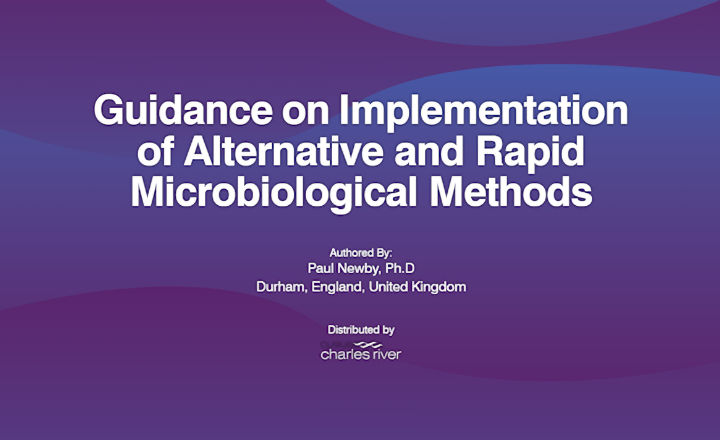Unraveling the Past:...
Micro ID Tracking an...
26th September 2023 Content supplied by: Charles River Microbial Solutions
Incorporating Quality Control Technologies in the Lab
A framework to effectively implement a rapid microbial method
If you’re reading this, it’s likely you have a clear understanding of the benefits and need for rapid microbiological methods (RMMs). You may also find it easy to understand the technology and how to use the instrument and its key features.
At the same time, you may be at a complete loss on how to actually implement the rapid method into your organization’s lab processes. Don’t worry, you’re not alone. Selecting and implementing an alternative or rapid method is often the first major project many QC microbiologists face that’s outside their comfort zone. Selection, evaluation, procurement, finances, and presenting a business case are much different than performing assays. If understanding the RMM adoption process sounds hard, keep reading. It’s about to get a lot easier.
Dr. Paul J. Newby, with 30 years of experience in the pharma industry and former Microbiology Modernization Lead at GlaxoSmithKline, understands this challenge. His approach to developing an efficient implementation process is detailed in his eBook “Guidance on Implementation of Alternative and Rapid Methods,” where he dissects the process for implementing an alternative or rapid microbial method in a simplistic, easy-to-manage framework.
The framework focuses on key stages in the implementation process, which is fundamentally a cycle. You can take years off of the process of implementing a rapid microbial method by simply having a plan prior to beginning the journey. This same framework can be repeated for any new technology, whether it be a rapid detection, identification, or preparation system. The three main phases are identified as Seek, Investigate, and Industrialize, with sub-tasks within each one. Below is a brief outline of each phase and key questions to ask:
Phase 1: Seek- Clarify needs.
In this step, Dr. Newby recommends articulating a clear understanding of your organization’s end goal. Is it to save warehousing costs, or maybe to address your data integrity concerns? - Review technologies.
When it comes to rapid methods, the number of on-market technologies can seem daunting. You can reduce the need to understand every technology by focusing on commercial readiness. - Identify candidates.
Pick out the top contenders that match your business needs. Dr. Newby recommends choosing a Commercial Off-the-Shelf System to avoid lengthy validation and evaluation efforts. Speaking of finding the right system, it’s also best to research whether the chosen vendor has validation support and materials offerings to aid in the process with regulatory authorities.
- Business & technical acceptance criteria.
Do you know what your current cost per test is, and how that compares to the cost per test with a new system? Comparison of labor costs and savings, as well as current and potential bottlenecks, are great places to start in evaluating your operational and financial factors. Most importantly, how does the new method compare in terms of performance? Before implementing any system, you have to first prove its non-inferiority to the compendial method of testing in terms of accuracy, limit of detection, specificity, and other areas. - Data integrity.
Dr. Newby lays out a comprehensive set of elements to ensure that data integrity and archiving needs are met. Labs need to understand the importance of accuracy, consistency, and availability of data. Recording results automatically with most rapid method technologies will ensure the integrity of your data over time when looking at these characteristics. - Proof of Concept.
This serves as an evaluation of the suitability of various test systems, and an investigation of claims made by suppliers. Dr. Newby recommends including a concise summary report of these findings to aid in the go/no-go decision-making process for subject matter experts.
- Validation.
PDA Technical Report No. 33, as well as USP <1223> and Ph. Eur. 5.1.6 provide invaluable information for this stage in the implementation process. While the end user is mainly responsible for carrying out the procedures of the validation process, the vendor of the new method may also provide support in terms of necessary documentation and testing services. - Registration.
Contacting regulatory authorities early on in the processes of selection, validation, and implementation of your RMM ensures your alignment with the guidance provided by these authorities. It’s important to remain in contact with subject matter experts during all stages of the process to allow for an easier validation undertaking. - Implementation.
Once integration into laboratory operations is underway, advocacy of laboratory innovation across industries and applications through shared knowledge is important. Many organizations would benefit greatly from a cost perspective and the ability to incorporate the method into global systems of operation. This would also benefit the patients and consumers in need of therapies and products tested with RMMs.
A similar approach, backed by quality control microbiology experts from some of the largest names in pharma, was used by organizations such as Roche Diagnostics and Merck & Co. The case studies recorded exemplify the planning, strategizing, and execution of an RMM, but they also offer a comparison of technology types to aid you in your decision.
Download the eBook to receive more details on this guidance and insightful tips for getting started, or contact Charles River directly using the green button below.
Tags:
Date Published: 26th September 2023
Source article link: View
Unraveling the Past: Tracing the
Micro ID Tracking and Trending:



